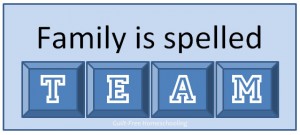Siblings as Best Friends follows right on the heels of The Family as a Team. Let me first explain my viewpoint on this topic. I grew up as the last of four children, five years younger than my nearest sibling. We were all spaced out over twelve years, a little more room between children each time, leaving me with little in common with my brother and sisters other than parents. Sibling rivalry was rampant, picking-on-the-little-kid was tolerated, and I was miserable. Fast-forward to the point in time when all of us became married adults. My nearest sibling and I became friends for the first time — twenty years behind schedule. When I recognized this wasted relationship and realized that we could have been friends much sooner, I determined not to let my own children waste that time in their own lives.
In teaching my children the lessons of taking turns in game-playing and how playing by the rules is fair to all players, I also tried to teach them that playing the game is fun for the whole time, while winning or losing the game only lasts for a moment. I explained over and over to them how my sister and I never enjoyed playing together as children because we were so hung up on things that did not really matter. We could not see through children’s eyes that friends will come and go, but siblings are forever. My children are not perfect examples, but they do get along most of the time. They have seen friends move away, they have matured at different rates from their friends, they have developed different interests from their friends, and through it all they have recognized that a sibling is always there. Siblings will be there to play with or talk with when no one else is around. If your children can develop solid friendships with their siblings, they will be giving themselves the gift of friends for life.
Sibling rivalry is reportedly at its peak between the ages of 4 and 8. Bear that in mind as you encourage your children to grow and mature and learn to understand their younger siblings’ maturity levels. We parents, myself included, often fall into the trap of expecting the oldest child to be more responsible than his age allows, but we also tend to neglect teaching responsibility to our younger children, allowing them to slide along as Oldest Child assumes the burden of leadership. I am a firm believer that explanations to children, giving reasons why behavior is acceptable or unacceptable, go much farther towards improving the behavior than just a simple “thanks” or “stop that.”
A very vital part of developing sibling friendships is not tolerating torture. If those little people are to become friends and remain friends, they cannot be allowed to pick on each other. Ridicule is out. Incessant tickling is out as well — as a former target of tickling myself, I consider it to be a form of child abuse. Parents, take a good look at the behavior between siblings (or between parents/adults and children as well) and analyze the motivation behind that behavior. Is it encouraging and strengthening to their relationship? Or does it stem from jealousy? A wonderful by-product of sibling friendships is seen when one stands up for another to a third-party antagonizer. If you do not defend your sibling, who will? And if they do not stand up for you, who will?
What better way to demonstrate Biblical principles and God’s agape love than to point out selfish, unacceptable behavior for the sin that it is and then replace it with true Love. “Greater love has no one than this, that one lay down his life for his friends.” (John 15:13 NASB) Use the opportunity to show your children the scriptures and remind them of how Jesus put His own needs and desires after those of others. Jesus did not demand His own way: He served.
Now a quick word about “extended” families: We have discovered recently that college roommates can become new siblings. When children have mastered sibling relationships, they are able to go off to college and successfully reside in a small dormitory room with total strangers. They simply treat the strangers as “new siblings I haven’t met before.” The college roommates do not always come with the siblings-as-friends philosophy as standard equipment, but they can catch on quickly! My daughter’s college friends (male or female) and roommates responded very well to being included as new members of our family. Sadly, many had never been treated with respect before in a family situation and loved the idea of not being ridiculed or picked on.






 Guilt-Free Homeschooling is the creation of Carolyn Morrison and her daughter, Jennifer Leonhard. After serious disappointments with public school, Carolyn spent the next 11 years homeschooling her two children, from elementary to high school graduation and college admission. Refusing to force new homeschooling families to re-invent the wheel, Carolyn and Jennifer now share their encouragement, support, tips, and tricks, filling their blog with "all the answers we were looking for as a new-to-homeschooling family" and making this website a valuable resource for parents, not just a daily journal. Guilt-Free Homeschooling -- Equipping Parents for Homeschooling Success!
Guilt-Free Homeschooling is the creation of Carolyn Morrison and her daughter, Jennifer Leonhard. After serious disappointments with public school, Carolyn spent the next 11 years homeschooling her two children, from elementary to high school graduation and college admission. Refusing to force new homeschooling families to re-invent the wheel, Carolyn and Jennifer now share their encouragement, support, tips, and tricks, filling their blog with "all the answers we were looking for as a new-to-homeschooling family" and making this website a valuable resource for parents, not just a daily journal. Guilt-Free Homeschooling -- Equipping Parents for Homeschooling Success!

Recent Comments